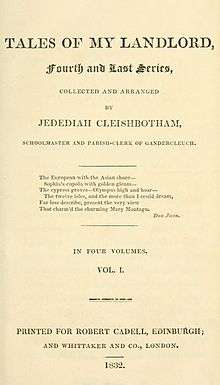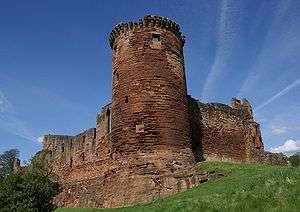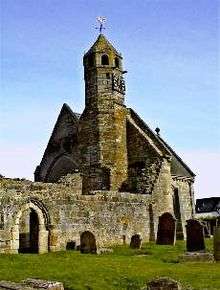Castle Dangerous
 | |
| Author | Sir Walter Scott |
|---|---|
| Country | Scotland |
| Language | English, Lowland Scots |
| Series | Tales of My Landlord (4th series) |
| Genre | Historical novel |
Publication date | November 1831 |
| Media type | Print (Hardback & Paperback) |
Castle Dangerous (1831) was the last of Walter Scott's novels published in his lifetime. It is part of Tales of My Landlord, 4th series.
Plot introduction
The story is set in Ayrshire and Lanarkshire around 1306, shortly after the death of William Wallace during the Wars of Scottish Independence. Lady Augusta has promised to marry Sir John de Walton provided that he can maintain possession of the castle he has captured for a year and a day. Regretting her promise, she resolves to travel in disguise to the castle to find some method of subversion.
The story had already been told in brief in his Essay on Chivalry, and in spite his failing health and a recent decline in popularity due to his politics, Scott made an effort to visit the area to collect information and adjust descriptions. Pained by James Ballantyne's criticisms of Count Robert of Paris, and by Ballantyne's unexpected disagreement on the subject of the recent Reform Bill, Scott did not discuss the book with him.
Only one ruined tower remains of Douglas Castle, and that tower dates from the 17th century. Scott called this area "Douglasdale"[1] in the preface of this book.
Plot summary
During the struggle for the Scottish crown between Edward I and Robert Bruce, the stronghold of his adherent Sir James Douglas, known as Castle Dangerous, had been taken by the English, and Lady Augusta had promised her hand and fortune to its new governor, Sir John de Walton, on condition that he held it for a year and a day.
Anxious to curtail this period, she determined to make her way thither, accompanied by her father's minstrel, Bertram, disguised as his son, and they were within three miles of their destination, when fatigue compelled them to seek shelter at Tom Dickson's farm. Two English archers, who were quartered there, insisted that the youth (Lady Augusta in disguise) should be left at the neighbouring convent of St Bride's, until Bertram satisfied Sir John as to the object of their journey, and this arrangement was approved of by Sir Aymer de Valance, the deputy governor, who arrived to visit the outpost. As they proceeded together towards the castle, the minstrel entertained the young knight with some curious legends respecting it, including the supernatural preservation of an ancient lay relating to the house of Douglas, and the future fate of the British kingdom generally. De Valance would at once have passed the stranger into the stronghold as a visitor; but the old archer Gilbert Greenleaf detained him in the guard room until the arrival of the governor, who, in the hearing of Fabian, Sir Aymer's squire, expressed his disapproval of his deputy's imprudence, and thus the seeds of disagreement were sown between them.

Sir John, however, wished to be indulgent to his young officers, and accordingly arranged a hunting party, in which the Scottish vassals in the neighbourhood were invited to join; but, at the mid-day repast, a forester named Turnbull behaved so rudely to the governor that he ordered him to be secured, when he suddenly plunged into a ravine and disappeared. The young knight took fresh offence at being ordered to withdraw the archers from the sport to reinforce the garrison, and appealed to his uncle, the Earl of Pembroke, who, instead of taking his part, wrote him a sharp reproof. He then opposed the governor's wish that the minstrel should terminate his visit, which induced Sir John to threaten Bertram with torture unless he instantly revealed his purpose in coming to the castle. The minstrel declined to do so without his son's permission; and, the Abbot having pleaded for delay on account of the boy's delicate health, Sir Aymer was ordered to meet a detachment at an outpost, and then to bring him to the castle to be examined. As he passed through the town he encountered a mounted warrior in full armour, whom neither the inhabitants nor his followers would admit having seen. The old sexton, however, declared that the spirits of the deceased knights of Douglas could not rest in their graves while the English were at enmity with their descendants. On reaching the convent, De Valence roused Father Jerome, and insisted that the youth (Lady Augusta) should at once accompany him. He was, however, allowed to return to his bed till daybreak, and upon the door of his room being then forced open, it was empty. During the night, Sister Ursula, who had hidden in the room, elicited Lady Augusta's secret, which she had already guessed, and, having narrated the circumstances under which she had entered the convent without taking the vows, they escaped through a concealed postern and found a guide with horses waiting for them. A scroll which his lady-love had left behind her explained matters to Sir John, who, in his despair, was comforted by the sympathy of his lieutenant; and the faithful minstrel, having been admitted to their confidence, steps were at once taken to track the fugitives.
Having reached a thicket, Sister Ursula (whose original name was Lady Margaret) disappeared to join her friends, and Lady Augusta was escorted, first by the celebrated Douglas, and then by Turnbull, to a spot where they met Sir John, to whom the forester delivered a message with which he refused to comply, and mortally wounded the man when he attempted to lead the lady away. But Sir James was at hand, and the two knights fought until summoned by the church bells to Palm Sunday service, at which the old bishop officiated in the presence of an excited assemblage of armed English and Scotch warriors eager to attack each other. Bertram met Lady Augusta in the churchyard, and was arranging for her safety, when De Walton and The Douglas renewed their combat, and an encounter also took place between De Valence and Sir Malcolm Fleming, Lady Margaret's lover. The life of the Sir Malcolm was saved by the intercession of Lady Margaret, and Sir John surrendered his sword and governorship on the arrival of a messenger with the intelligence that an English force, commanded by the Earl of Pembroke, which was advancing to prevent an anticipated attack on the castle, had been utterly defeated by Bruce and his followers. He and his troops, however, were allowed to retire with their arms, Sir James Douglas having chivalrously transferred his claim upon her lover to the Lady Augusta of Berkely, who, in return for his courtesy, decorated the brave Scotchman with a chain of brilliants which had been won in battle by her ancestor.
Characters

- Bertram, an English minstrel
- "Augustine", his son, actually Lady Augusta of Berkely
- Tom Dickson of Hazelwood, a vassal of the Douglas estate
- Charles Dickson, his son
- Sir John de Walton, Governor of Castle Dangerous
- Sir Aymer de Valence, deputy Governor
- Fabian Harbothel, his squire
- Gilbert Greenleaf, an old archer
- Abbot Jerome, of St Bride's convent
- Sister Ursula, afterwards Lady Margaret de Hautville
- Sir Malcolm Fleming, her lover
- Michael Turnbull, a border forester
- Lazarus Powheid, sexton of Douglas Kirk
- The Knight of the Tombs, Sir James Douglas
- The Bishop of Glasgow
- The Earl of Pembroke
References
- ↑ The term Douglasdale was used in the preface of Castle Dangerous, the last romance work of Sir Walter Scott, transmitted from Naples, Italy circa 1832 the following link at Scottish-Places.info
This article incorporates text from the revised 1898 edition of Henry Grey's A Key to the Waverley Novels (1880), now in the public domain.